
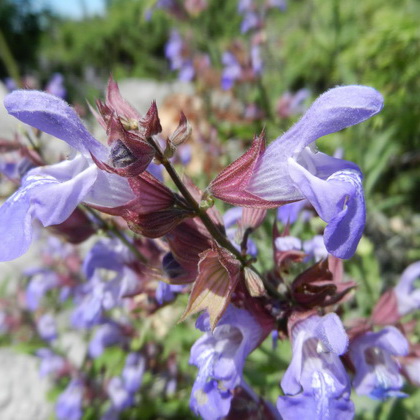
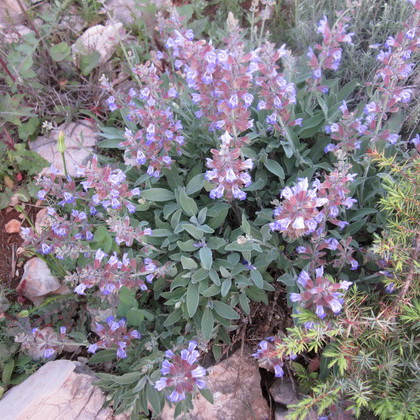
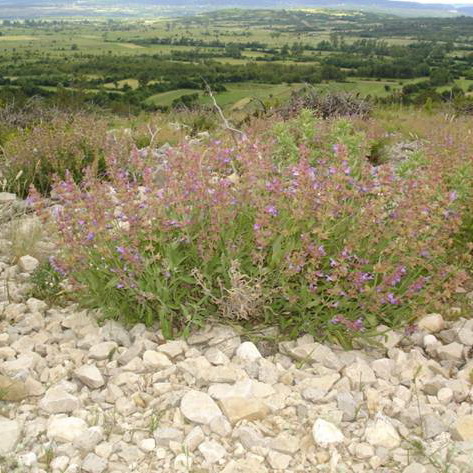
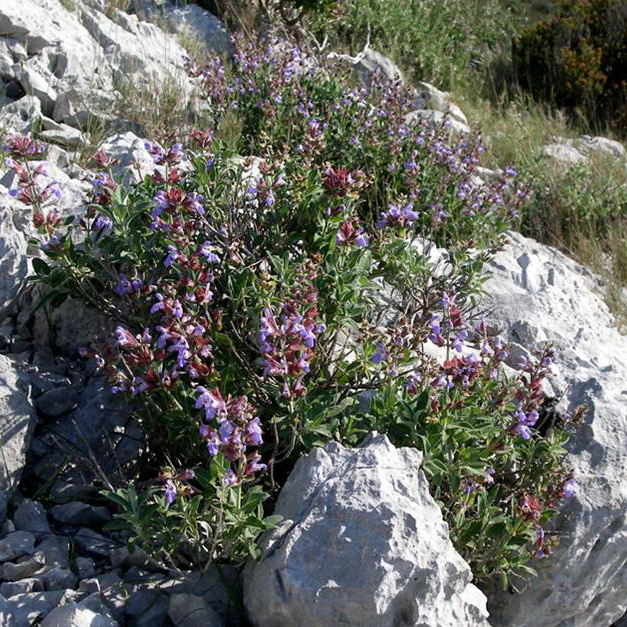
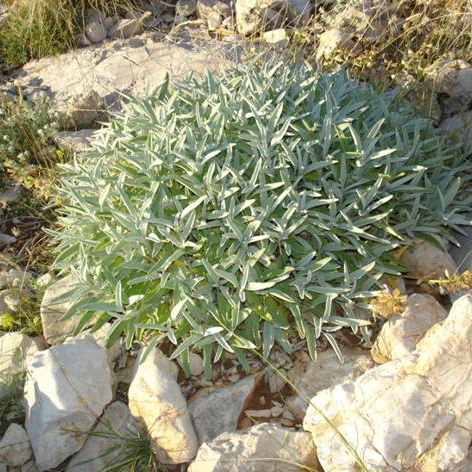
Salvia species
Genus Salvia L.
The sage (Salvia) is cosmopolitan genus that has approximately 1,000 species with three main evolutionary centers: central and south America (ca. 500 species), central Asia and Mediterranean (ca. 250 species), and East Asia (ca. 90 species) (Walker et al. 2004). This genus includes annual, biannual and perennial herbs, and ligneous shrubs. Leaves are ovoid, cordiform or sagittate, undivided or pinnate, with entire, dentate or undulate margin. Basal leaves are usually in rosettes. Flowers are grouped in simple or in branched, dense or verticillate, racemose inflorescence, rarely in panicle. Flowers are big, zygomorphic, blue, violet to red, rarely white or yellow. Calyx is bilabiate, tubulous or campanulate. Corolla is bilabiate, erect or slightly arcuate, with entire or serrate margin; while lower lip is wide and trilobed. Fruit is tatrachene formed by four glabrous oval nuts. Many representatives of this genus are covered by hairs that protect plants from drought and sun rays, and diverse glandular hairs on all plant surfaces produce essential oils with protective function against animal and insect bites (Werker 1993; Bisio et al. 1999).
The characteristic of the genus Salvia is presence of two stamens in form of lever mechanism, that are adapted to entomophily. Within the genus, morphology of stamens is very variable and the lever mechanism in majority of species in not specialized for a single pollinator, while in other species is completely reduced (Wester & Classen-Bockhoff, 2007). This unique pollination mechanism has important role in speciation of the genus Salvia and it was considered as a strong reason for monophyly of the genus Salvia. However, according to recent phylogenetic researches (Walker et al. 2004; Walker & Sytsma, 2007) the lever mechanism in the genus Salvia has evolved independently at least three times, and that was strong evidence of polyphyletic origin of the genus. The name of the genus Salvia derives from a type species of the genus Salvia officinalis L. (Dalmatian sage), which was used as an ornamental and medicinal plant from Antique period and perhaps earlier. The name Salvia derive from Latin word 'salvus' (healthy) and Latin verb 'salvare' (to save, to cure). In Croatian flora 19 taxa of the genus Salvia are registered (Nikolić, 2013). A group of morphologically similar taxa form Salvia officinalis complex that comprise eight to ten perennial species, which are distributed in the Mediterranean and in Middle East. The three most significant species are S. fruticosa Mill., S. tomentosa Mill. and S. officinalis L., of which the latest is economically the most important.
Dalmatian sage (Salvia officinalis L.)






Dalmatian sage (Salvia officinalis L.) belongs to a group of Balkan-Apennine endemic species. It was described by Linné in 1753. Dalmatian sage is perennial ligneous shrub up to 60 cm. Stems are erect or procumbent with numerous fine hairy dark green branches. Root system is well developed. Leaves are petiolate, elongated, opposite, simple, sometimes with two basal lobes (especially in juvenile stadium), with serrate margin, rugose surface, more or less contracted at the base, with white hairs, on lower surface are greenish, greenish-grey, while on upper surface are argentous and densely hairy when juvenile. Flowers are on 2-4 mm long pedicel, in pseudoverticillasters with 5-10 flowers that form spurious composed spike. Calyx is 10-14 mm long, hairy, with five teeth. Corolla is ca. 35 mm long, rosy, violet-blue, rarely white. Fruit is spherical to oval nut, 2-3 mm long, dark-brown. Flowering period of Dalmatian sage is from March to July but it depends on climatic conditions on the habitat. Dalmatian sage has simple and glandular (stalked and capitate) hairs. Stalked hairs produce mixed secrete of hydrophilous and lipophilous components and are present on leaves and on calyx. The genus Salvia has four types of capitate hairs, that differs in structure, occurrence on plant, function, and way of secrete production (Corsi & Bottega, 1999). Dalmatian sage grows mainly in costal part of countries of eastern Adriatic region: Slovenia, Croatia (Kvarner area and Dalmatia), Mediterranean part of Bosnia and Herzegovina, Montenegro and Albania (Kušan, 1941; Ristić et al. 1999). Outside the Mediterranean area it grows in southern Serbia and Kosovo (Janković, 1982) and in Macedonia. Southern border of its distribution is northwest part of Greece, where it occurs only in continental part (Karousou et al. 2000), while the northern limit of areal is Trieste (Italy). Dalmatian sage is cultivated in many countries with continental climate around the word: in Ukraine, Moldavia, Germany, Slovakia, Bulgaria, Romania, Italy, Great Britain, Canada, USA, Turkey, India, Japan, Indonesia (Java), Tanzania, South Africa, Antilles, Brazil, Australia, New Zealand and others. In many countries it is naturalized (Randall, 2007). It is assumed that Dalmatian sage was planted by ancient Romans all over Europe, and certainly was cultivated in the gardens of medieval monasteries.
Short-toothed sage (Salvia brachyodon Vandas)
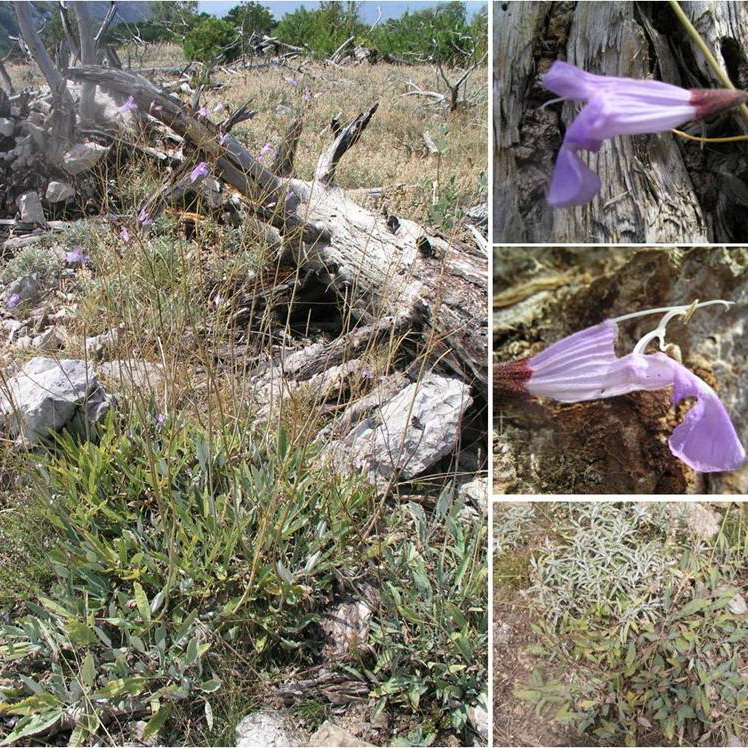


Short-toothed sage (Salvia brachyodon Vandas) is Illyrian-Adriatic endemic species. It was described by Karl Vandas from dry carbonate hills from the area between fort Ulice and Vrbanja on Mt Orjen on the border between Montenegro and Bosnia and Herzegovina (Vandas 1889). Short-toothed sage is perennial plant. Stems are gay-whitish, erect, 70-80 cm high, in lower part slightly white lanate, and in upper part are glabrous. Leaves are 6-14 cm long, 1.5-4 cm wide, with long petiole. Leaf blade is entire or pinnate divided, terminal leaflet is biggest, with 1-3 lateral leaflets that are 2-4 cm long and 5-7 mm wide, usually are concrescent with terminal leaflet. Well developed leaves are weakly hairy on upper part, on lower part are densely white tomentose while older leaves are coriaceous, yellow-greenish with prominent veins and scarcely hairs. Margin of leaf blade is slightly crenate. Inflorescence is laxly flowered panicula, composed of few flowers that are on long lateral branches, flower bracts are caducous. Calyx is tubular-campanulate, 8-10 mm long, glandular-glutinous with prominent longitudinal veins. Calyx teeth are almost equal, broadly triangular, with acuminate apex. Corolla is 35-40 mm long, bilabiate, pale violet, glandular and sparsely hairy. Flowering period of this species is summer time, from July to September. Short-toothed sage is diploid species with 2n=14 chromosomes (Šilić 1990, Maksimović et al. 2007).
S. brachyodon grows only in Croatia and Bosnia and Herzegovina (Abadžić & Šilić, 1982). In Croatia this species is distributed in southern Dalmatia, and it is reliably known only from Pelješac peninsula on mount Sv. Ilija (Mt Vipera) and from hills northern of Cavtat (Velji do) from Konavle region. On Pelješac peninsula short-toothed sage grows in composition of sunny rocky grasslands within sparse forests of Dalmatian black pine. Therefore, S. brachyodon can also be found in garrigues and on forest margins. On Mt Orjen and on hills of Cavtat, short-toothed sage grows within thermophilous forests and degredated stadia of Quercus pubescens. According to all know localities we can say that this is one of the rarest endemic species of Dinaric karst. Although its rarity, S. brachyodon is not treated as endangered, it is protected by Law and it has category of near threatened plant (NT). Some recent population genetic studies (Pruša 2011, Radosavljević et al. 2011) of S. brachyodon reveled new insight on negative population trends of this rare species. According to results of Pruša (2011), population of S. brachyodon from Sv. Ilija on Pelješac was affected by genetically know effect of bootleneck. It means that this population had wider areal of distribution in very recent past, while today is reduce on present small size area. From a genetic point of view, population from Pelješac peninsula is in negative trend, and it is necessary to reevaluate new treatment and categorization of IUCN threats for accurate and better protection of this rare species. Morphologically and genetically, S. brachyodon belongs to a group of Dalmatian sage (S. officinalis), and morphologically is closer to Balkan endemic species S. ringens Sibth. & Sm., which is distributed in central and southern Balkans (Albania, Serbia, Macedonia, Bulgaria, Romania and Greece). A very detailed contribution to the knowledge of short-toothed sage was given by Barbalić (1956), where author hypothesized great relationship among Greek sage (S. fruticosa) and Dalmatian sage (S. officinalis), as well as closer relationship to oriental species rather than European sage species.
Greek sage (Salvia fruticosa Mill.)
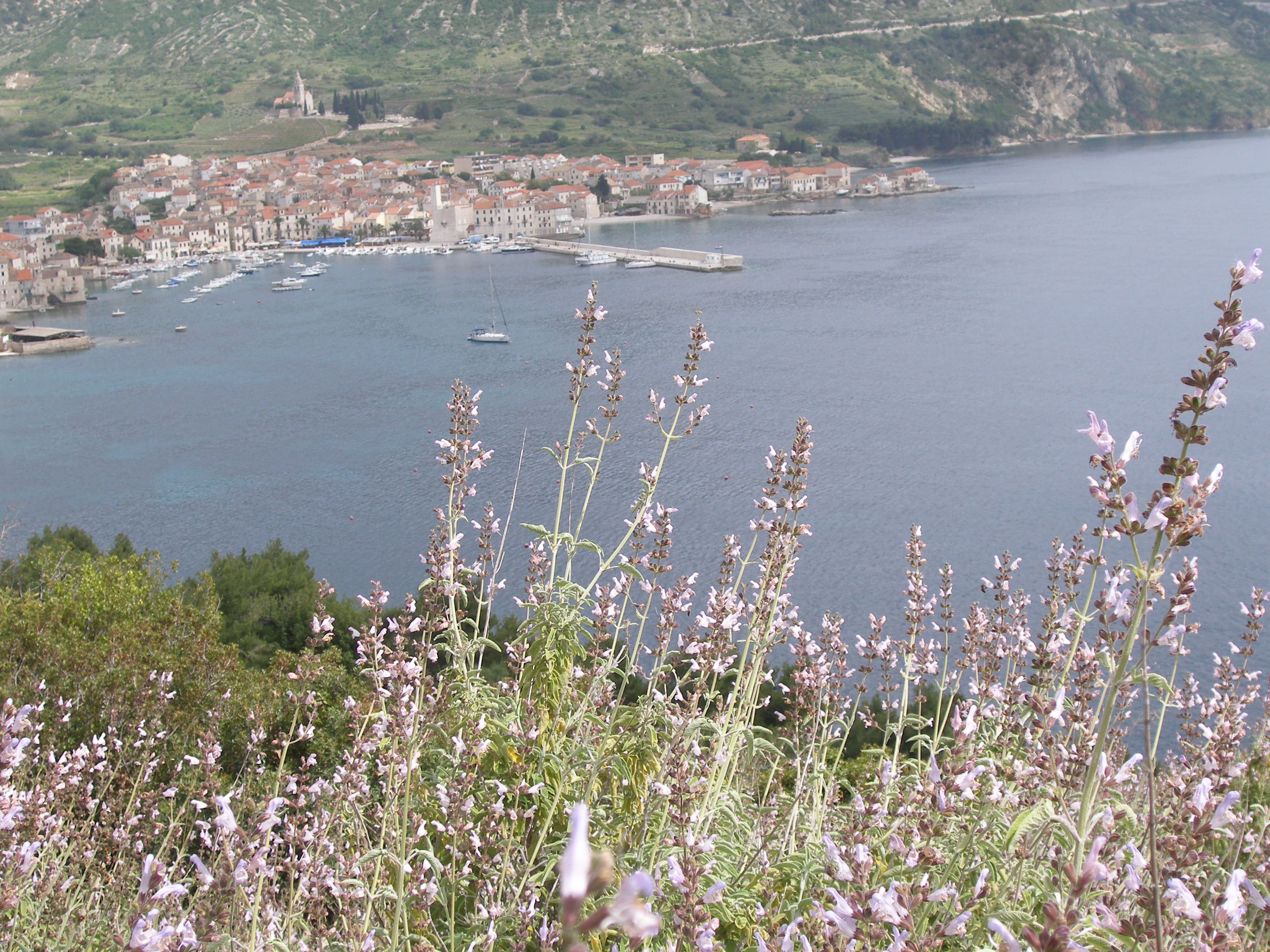
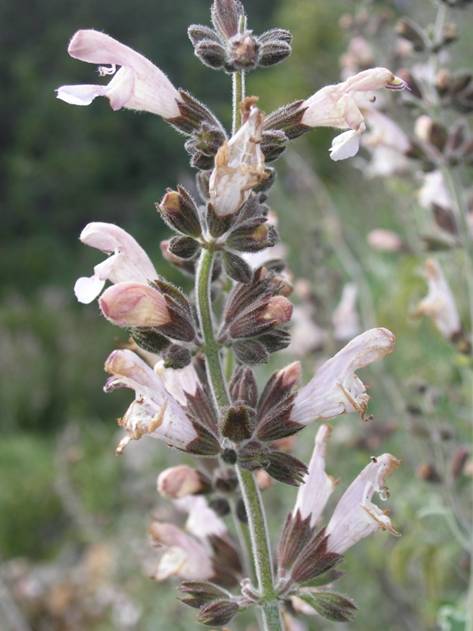
Morphologically, Greek sage (Salvia fruticosa Mill.) is similar with Dalmatian sage (S. officinalis L.). As autochthonous plant it is distributed in East Mediterranean basin from Italy, Sicily and Libya, south Balkan Peninsula (Albania and Greece) to Syria (Reales et al. 2004). In Greece it is frequent and it grows in dense populations from sea level up to inland. In Croatia, Greek sage is known only from the island of Vis where it forms small isolated populations in the vicinity of Komiža. We assumed that this species was introduced in our region in Antique period from 4th century BC. It grows on anthropogenic habitats on recent or abandoned culture of carobs, vineyards, and spontaneously in vegetation of garrigues and macchias. S. fruticosa is perennial frutiocose shrub up to 120 cm. Stem is angular and densely hairy. Leaves are petiolate, simple or pinnate with 1-2 laterally pairs of oval segments and with terminal elongate elliptical segment. Inflorescence is simple, slightly divaricated, flowers are arranged in few verticillasters. Calyx is violet, actinomprohic, tubulous, 5-12 mm long, minutely hairy, glandular or eglandular. Corolla is violet, rarely white, 16-25 mm long. S. fruticosa is morphologically very variable, and it forms morphologically diverse populations under environmental conditions. Greek sage is medicinal and melliferous plant. In Croatia it is protected by the Law and it has near threatened (NT) category.
Auriculate sage (Salvia x auriculata Mill.)
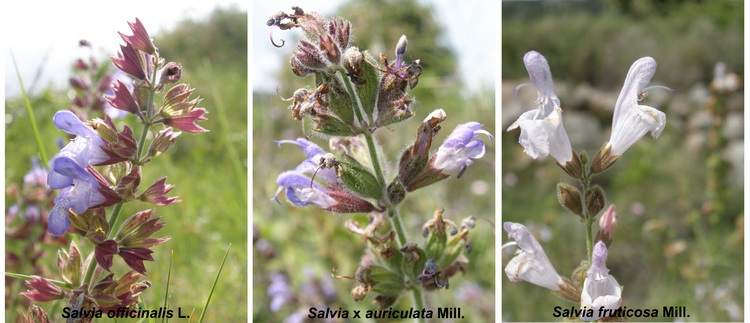
Auriculate sage (Salvia x auriculata Mill.) is natural hybridogenous species between Dalmatian sage (S. officinalis) and Greek sage (S. fruticosa). S. x auriculata has entire leaves sometimes with 1-2 basal lobes that have shape of auricula. This hybrid got it name because of auriculate leaves. Inflorescence is simple or branched, and flower bracts are caducous. Calyx is almost actinomorphic, tubulous or campanulate, 8-12 mm long. The whole plant is very hairy. For this hybrid are characteristic eglandular patent hairs, that are visible by eye, short glandular hairs, long capitulate glandular hairs, glandular stalked and glandular sessile hairs (Reales et al. 2004). In Croatian flora, auriculate sage is known only from one locality, from Komiža on the island of Vis, where it grows with both parental species. Till now, this hybrid is not protected by the Law.
Reference:
Abadžić, S., Šilić, Č. (1982): Horologija, ekologija i fitocenološka pripadnost vrste Salvia brachyodon Vandas u flori jugoslavija. Glas. Repub. Zavoda Zašt. Prirode – Prirodnjačkog Muzeja Titograd 15: 125-131.
Barbalić, L. (1956): Prilog poznavanju vrste Salvia brachyodon Vand. Biol. Glas. Period. Biol. 9: 5-10.
Bisio, A., Corallo, A., Gastaldo, P., Romussi, G, Ciarallo, G., Fontana, N, ... Profumo, P. (1999): Glandular Hairs and Secreted Material in Salvia blepharophylla Brandegee ex Epling Grown in Italy. Annals of Botany 83(4): 441-452.
Corisi, G., Bottega, S. (1999): Glandular hairs of Salvia officinalis: new data on morphology, localization and histochemistry in relation to function. Annals of Botany 84(5): 657-664.
Janković, M.M. (1982): Prilog poznavanju vegetacije Šarplanine sa posebnim osvrtom na neke značajne reliktne vrste biljaka. Glas. Inst. bot. i Bot. Univ. u Beogradu, XIII, 15 (1-3): 75-129.
Karousou, R., Hanlidou, E., Kokkini, S. (2000): The sage plant of Greece: distribution and intraspecific variation. U: Sage: the genus Salvia. Kintzios S. E. (ur). Amsterdam. Harwood Academic Publishers. 27-46.
Kušan, F. (1941): Kadulja, Salvia officinalis L. Vjesnik ljekarnika 15: 374-376, 16: 407-416, 17: 448-450, 18: 483-487.
Maksimović, M., Vidic, D., Miloš, M., Šolić, M.E., Abadžić, S., Siljak-Yakovlev, S. (2007): Effect of the environmental conditions on essential oil profile in two Dinaric Salvia species: S. brachyodon Vandas and S. officinalis L. Biochem. Syst. Ecol. 35: 473-478.
Nikolić, T. (2013): Flora Croatica Database. University of Zagreb, Faculty of Science. (accessed 10.11.213.)
Pruša, M. (2011): Genetička raznolikost i rasprostranjenost vrsta: Salvia brachyodon Vandas vs. Salvia officinalis L. Rad za Rektorovu nagradu, Botanički zavod PMF-a, Zagreb, 1-56.
Radosavljević, I., Jakše, J., Javornik, B., Šatović, Z., Liber, Z. (2011): New microsatellite markers for Salvia officinalis L. (Lamiaceae) and cross-amplification in closely related species. American Journal of Botany e316–e318.
Randall, R. (2007): Global compendium of weeds (GCW), (Pristupljeno 21. listopada 2013).
Reales, A., Rivera, D., Palazon, J.A., Obon, C. (2004): Numerical taxonomy study of Salvia sect. Salvia (Labiatae). Botanical Journal of the Linnean Society 145: 353-371.
Ristić, M.S., Brkić, D.D., Nastovski, T.Lj. (1999): Hemijski sastav etarskog ulja žalfije. U: Žalfija (Salvia officinalis L.). Brkić D. (ur.). Institut za proučavanje lekovitog bilja “Dr Josif Pančić” Beograd i Art Grafik, Beograd, 29-42.
Šilić, Š. (1990): Endemične biljke. Svjetlost, Sarajevo.
Vandas, K. (1899): Beiträge zur Kenntniss der Flora von Süd-Hercegovina, Österr. Bot. Z. 39: 178-181.
Walker, J.B., Sytsma, K.J., Treutlein, J., Wink, M. (2004): Salvia (Lamiaceae) is not monophyletic: implications for the systematics, radiation, and ecological specializations of Salvia and tribe Mentheae. American Journal of Botany 91(7): 1115-1125.
Walker, J.B., Sytsma, K.J. (2007): Staminal evolution in the genus Salvia (Lamiaceae): molecular phylogenetic evidence for multiple origins of the staminal lever. Annals of Botany 100(2): 375-391.
Werker, E. (1993): Function of essential oil secreting glandular hairs in aromatic plans of Lamiacea – a review. Flavour and Fragrance Journal 8(5): 249-255.Wester, P., Classen-Bockhoff, R. (2007): Floral diversity and pollen transfer mechanisms in bird-pollinated Salvia species. Annals of Botany 100(2): 401-421.
: